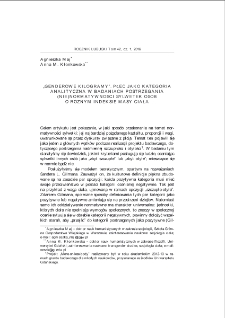Repozytorium Uniwersytetu Zielonogórskiego udostępnia 9 272 obiektów cyfrowych
Obiekt
Tytuł: "Genderowe kilogramy". Płeć jako kategoria analityczna w badaniach postrzegania (nie)normatywności sylwetek osób o różnym indeksie masy ciała = "Gender kilograms": sex as an analytic category in research on the perception of (non)normativity of silhouettes of people with different body mass indices
Współtwórca:
Paprzycka, Emilia - red. ; Mianowska, Edyta - red.
Tytuł publikacji grupowej:
Streszczenie:
Celem artykułu jest pokazanie, w jaki sposób przekonania na temat normatywności sylwetki: jej najbardziej pożądanego kształtu, proporcji i wagi, uwarunkowane są przez dyskursy związane z płcią. Temat ten pojawił się jako jeden z głównych wątków podczas realizacji projektu badawczego, dotyczącego postrzegania nadmiernej szczupłości i otyłości. ; W badaniu tym starałyśmy się dowiedzieć, jakimi kryteriami posługują się ludzie, oceniając sylwetki innych osób jako "zbyt szczupłe" lub "zbyt otyłe"; mieszczące się w normie bądź nie. Posłużyłyśmy się modelem teoretycznym, opartym na rozważaniach Sandera L. Gilmana.
Abstract:
The aim of this article is to show in what way the notions of normativity of silhouette, its most desirable shape, proportion and mass, are determined by discourse connected with sex. The starting point of these considerations are the results of research within the sociology of the body. The research was carried out on a group of 60 individuals with the method of in-depth interview, whose theme concentrated on perception of normativity of silhouettes of people with different BMIs. ; The aim of the interview was to select and interpret the main topics associated by individuals with the issues of overweight and underweight and their cultural meanings. The analysis shows that cultural meanings of opposite categories "slim" - "obese" are significantly connected with gender: the assessment of who is slim and who is obese depends not only on the sexes of the observing and observed individuals, but is also conditioned by a number of assumptions on the perception of roles connected with sex, socially perceived ideals of a beautiful and attractive body, and also stereotypes of femininity and masculinity.
Wydawca:
Zielona Góra: Lubuskie Towarzystwo Naukowe ; Zielona Góra: Uniwersytet Zielonogórski, Wydział Pedagogiki, Psychologii i Socjologii
Format:
Identyfikator zasobu:
Strony:
Źródło:
Rocznik Lubuski, tom 42, część 1
Jezyk:
Prawa do dysponowania publikacją:
Biblioteka Uniwersytetu Zielonogórskiego
Kolekcje, do których przypisany jest obiekt:
- Repozytorium > Jednostki organizacyjne > Wydział Nauk Społecznych
- Repozytorium > Typy utworów > Artykuły
- Repozytorium > Czasopisma naukowe i serie wydawnicze UZ > Rocznik Lubuski
Data ostatniej modyfikacji:
23 maj 2024
Data dodania obiektu:
23 maj 2024
Liczba wyświetleń treści obiektu:
126
Wszystkie dostępne wersje tego obiektu:
https://zbc.uz.zgora.pl/repozytorium/publication/89072
Wyświetl opis w formacie RDF:
Wyświetl opis w formacie OAI-PMH:
Obiekty Podobne
Herudzińska, Małgorzata H. Paprzycka, Emilia - red. Mianowska, Edyta - red.
Trzcińska, Dorota Świderska, Dorota Tabor, Piotr Olszewska, Elżbieta Asienkiewicz, Ryszard - red. Tatarczuk, Józef - red.
Jasik-Pyzdrowska, Justyna Bonikowska, Iwona Asienkiewicz, Ryszard - red. Tatarczuk, Józef - red.
Górniak, Krystyna Lichota, Małgorzata Popławska, Helena Dmitruk, Agnieszka Asienkiewicz, Ryszard - red. Tatarczuk, Józef - red.
Kubanová, Kateřina Gorzelana, Joanna - red. nauk. Seul, Anastazja - red. nauk.
Płonecka, Ilona Szafraniec, Krystyna- red. Zielińska, Maria - red.

